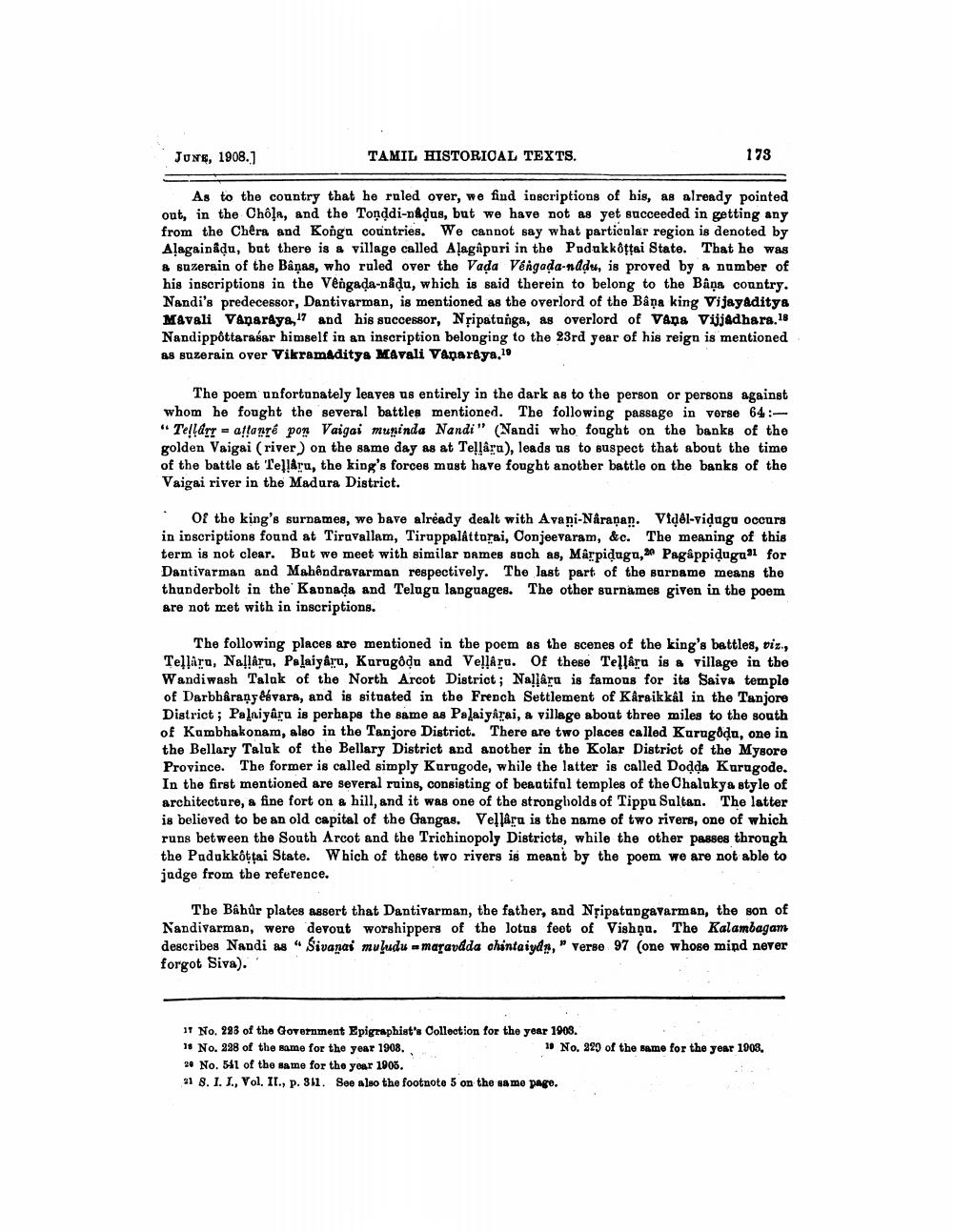________________
JUNE, 1908.]
TAMIL HISTORICAL TEXTS.
173
-
-
As to the country that he ruled over, we find inscriptions of his, as already pointed out, in the Chola, and the Tondi-nadus, but we have not as yet succeeded in getting any from the Chêra and Konga countries. We cannot say what particular region is denoted by Alagainkdu, but there is a village called Alagipuri in the Pudukkottai State. That he was & suzerain of the Bâņas, who ruled over the Vada Vengada-nadu, is proved by a number of his inscriptions in the Vengada-nadu, which is said therein to belong to the Baņa country. Nandi's predecessor, Dantivarman, is mentioned as the overlord of the Bâņa king Vijayaditya Mavali Vanaraya, 17 and his successor, Nřipatunga, as overlord of Vaņa Vijjadhara.18 Nandippóttarasar himself in an inscription belonging to the 23rd year of his reign is mentioned As suzerain over Vikramaditya Mavali Vanaraya.10
The poem unfortunately leaves us entirely in the dark as to the person or persons against whom he fought the several battles mentioned. The following passage in verse 64:"Tellárr = aftanré pon Vaigai muninda Nandi" (Nandi who fought on the banks of the golden Vaigai (river) on the same day as at Tellara), leads us to suspect that about the time of the battle at Telláru, the king's forces must have fought another battle on the banks of the Vaigai river in the Madura District.
of the king's surnames, we have already dealt with Avani-Naranan. Vidél-vidago occurs in inscriptions found at Tiruvallam, Tiruppalâttorai, Conjeevaram, &c. The meaning of this term is not clear. But we meet with similar dames such as, Märpiduga, 20 Pagappidugul for Dantivarman and Mahendravarman respectively. The last part of the surname means the thunderbolt in the Kannada and Telugu languages. The other surnames given in the poem are not ret with in inscriptions.
The following places are mentioned in the poem as the scenes of the king's battles, viz., Tellára, Nallâru, Palaiyaru, Kurugôdu and Ve!!Aru. Of these Tellára is & village in the Wandiwash Talak of the North Arcot District; Nallara is famous for its Saiva temple of Darbharaṇyéévara, and is situated in the French Settlement of Káraikkal in the Tanjore District ; Palaiyaru is perhaps the same as Palaiyarai, a village about three miles to the south of Kumbhakonam, also in the Tanjore District. There are two places called Kurugôda, one in the Bellary Taluk of the Bellary District and another in the Kolar District of the Mysore Province. The former is called simply Karugode, while the latter is called Dodda Kurugode. In the first mentioned are several ruins, consisting of beautiful temples of the Chalukya style of architecture, a fine fort on a hill, and it was one of the strongholds of Tippu Sultan. The latter is believed to be an old capital of the Gangas. Vellára is the name of two rivers, one of which runs between the South Arcot and the Trichinopoly Districts, while the other passes through the Padukkottai State. Which of these two rivers is meant by the poem we are not able to judge from the reference.
The Bahúr plates assert that Dantivarman, the father, and Nțipatangavarman, the son of Nandivarman, were devout worshippers of the lotus feet of Vishịu. The Kalambagam describes Nandi as "Sivanai muludu = maravdda chintaiydn,” verse 97 (one whose mind never forgot Siva).
IT No. 293 of the Government Epigraphist's Collection for the year 1903. 15 No. 328 of the same for the year 1908.
No. 229 of the same for the year 1908. 20 No. 541 of the same for the year 1905. 21 8. 1. J., Vol. II, p. 311. See also the footnote 5 on the same page.




